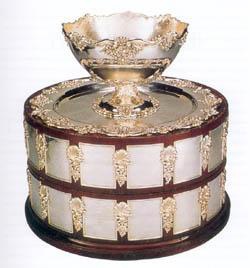
Accra, Feb 24, GNA - Ghana's national tennis team, the Golden Racket would next month, host their Finnish counterparts in the crucial Euro-African Zone II Davis Cup competition hoping to gain promotion to the Euro-African Zone I.
To give our subscribers a better understanding of what the Davis Cup is all about, the GNA Sports Desks together with the Captain of the Golden Racket, coach David Churcher have researched into the history of the competition. (Source: ITF MEDIA GUIDE AND 100years of Davis Cup)
HOW IT STARTED!
When a twenty-year old Harvard student, Dweight Fillery Davis of St. Louis, Missouri, offered a large silver punch bowl for international tennis competition in 1900, he could not in his widest dreams have imagined what he was starting. More than 100 years on, the Davis Cup has become the premier team competition in tennis.
In the early years, only two nations competed for temporary ownership of the Davis Cup trophy, the United States and the British Isles. Before the First World War, France, Belgium, Austria, Australia, Germany and Canada had joined the USA and Britain in competing for the Davis Cup.
WINNERS
However, until 1927 the only three nations to win the cup were the United States (10 times), Australia/Asia (6 times) and the British Isles (5). Then came the Swashbuckling era of France's "Four Musketeers Jean Borotta, Rene Lacoste, Henri Cochet and Jacques Bugnon - when the trophy was claimed by the French six years in succession.
Great Britain were the next to dominate, capturing the Davis Cup from the French in 1933 in Paris and holding it until they finally lost out to the USA at Wimbledon in 1937. It was Australia and Americans who assumed dominance after the Second World War with 16 and 12 victories' respectively.
MEET THE GREATS
From its inception, Davis Cup has attracted top players like Roger Federer, Pete Sampras, Andre Agassi, Lleyton Hewit, Gustavo Kueten, Yevgeny Kafelnikov, Pat Rafter, Tim Herman who are all modern day members of a century old club whose founding fathers include such legends of the game as Fred Perry, Renene Lacoste, Bill Tiden Rod Laver, Arthur Ashe, Boris Becker and John McEnroe.
FORMAT
Each tie of the Davis Cup consists of five matches; four singles and one doubles played out over three days. On the opening day, the Number Two singles players for each nation are mandated to engage the Number One seed of the opposing nation.
The Number One players are matched against each other on day three while the second seeds clash each other in the fifth match. All are played over best-of-five-sets with no tiebreak in the fifth set. This format requires skilful play, intense concentration and endurance from the players that naturally adds to the drama of the competition.
THE ULTIMATE AND ACHIEVERS
The pinnacle of the Annual Davis Cup Competition is the World Group. Sixteen nations are drawn against each other in a knockout format leading up to the Davis Cup final. Nations that have gone on to win the Davis Cup title include the USA, Australia, Great Britain, France, Sweden, Germany, Italy, and Spain with South Africa representing the African continent.
Each year's world group competition is made up of four rounds scheduled throughout the year, culminating in the Davis Cup final played in late November and early December.
Below the World Group consists three regional zones, the Euro/African, American and Asia/Oceania Zones in which Group I, II, III and IV ties are played.
The goal is to move up group by group until the World Group and possibly the title is achieved.
The eight winners of Zonal Group I competition are drawn against the eight World Group first round losers in September's World Group qualifying round. Stakes are always high at this stage; as the winners will go on to compete in World Group in the subsequent year. As many as 142 nations emerged from Zonal group IV and rose through the ranks before reaching the elite World Group in 2002.
THE PRIDE
The Davis Cup promotes a wonderful loyalty and pride. It has involved players as young as 14 and as old at 58. Italy's Nicole Pietrangeli played 164 matches in 66 ties.
Nobody has better articulated the Davis Cup's enduring attraction than the late Arthur Ashe, who both played for and captained the United States. In 1977 he wrote, "The Davis Cup endures as few other institutions have done before it. The Davis Cup is not a place or a player, a cup or a contest, a name or a notion. It is an idea, and it will always be just that. Furthermore, it is not an accident that the world ideal is derived from the word idea. Dwight Davis must have been an idealist when in 1900 he went to the trouble of donating the huge silver bowl, a symbol of friendly tennis rivalry.
The Davis Cup rules have changed, political systems have changed even the cup itself has changed, but the idea and its deals are immutable". 24 Feb. 05